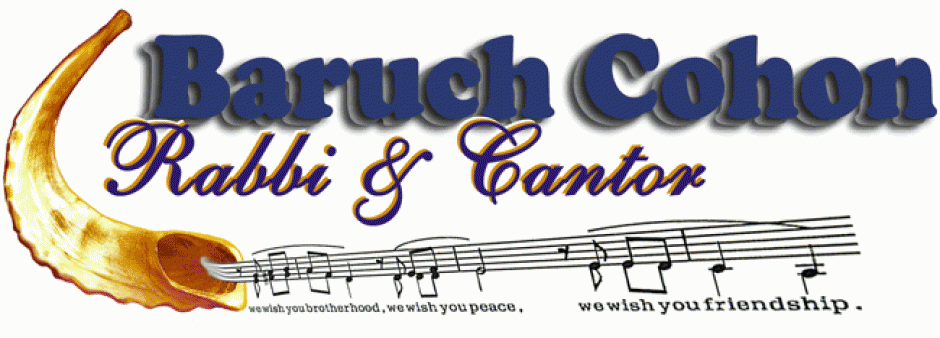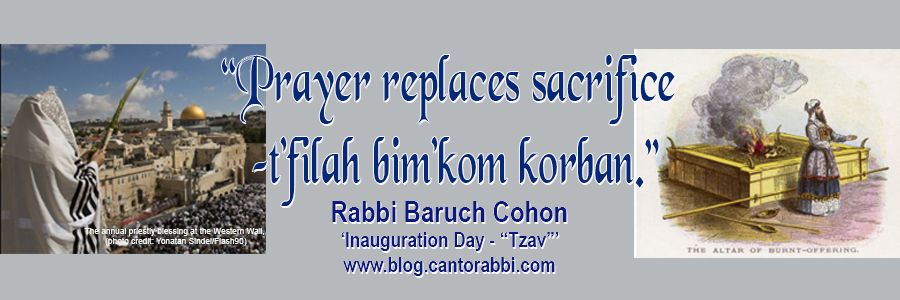
A TRIPLE OCCASION — by Rabbi Baruch Cohon
This coming Shabat morning in every traditional synagogue, when the Torah service starts, not one but three scrolls will be taken out of the Ark and carried in procession. Arriving on the bema, the first Sefer Torah will be opened to the Sedrah of the week, Tazria, a detailed description of some laws of ritual contamination. The second scroll will be opened to the commandment of observing the New Moon, since this Saturday will be the first day of Nisan. And the third scroll will be opened to tell the special significance of this month, here called“the head of the months.” We can expect our services to end a little later than usual this week.
Our religious calendar thus gives us an unusual combination of subject matter. Tazria introduces the concept that a mother’s blood in the process of delivery contaminates her. If her baby is a boy, for the next seven days she must not join her husband in union, until the day of the B’ris. In Temple times she was not permitted to enter the House of G-d or to eat sacrificial meat for the next 33 days. And if the baby is a girl, the time of the mother’s ritual contamination is doubled. Why the difference? Theories about this difference are varied, but it would seem to place special importance on the birth of a female who will grow up to experience the monthly cycle, and some day may also bear new life.
That’s just part of the first reading. Tazria goes on to explore a skin disease which is considered to be the effect of spreading slander. Translated “leprosy” in our English bibles, it was not necessarily fatal in Biblical times, but whoever had it was sent to pitch a tent outside the camp. If anyone approached, the “leper” had to call out “taMey taMey – Contaminated!” to prevent contact with one who was tahor – pure. Not the most attractive section of Leviticus.
But now comes our second Torah scroll with the special reading for Rosh Khodesh, the New Moon. Pious celebrants already greeted the skinny crescent last night, if the sky was clear enough. And Rosh Khodesh is traditionally a special happy day for Jewish women, a reward for their decision notto offer their jewelry for the creation of the Golden Calf.
Finally we come to Sefer Torah #3 – the Maftir section called Hakhodesh – THE month. “This month is the beginning of months for you,” it says, “first of the months of the year.” Now we know when our year begins, don’t we? In the fall, right? The first of Tishri — Rosh Hashanah, Yom Kipur, the whole High Holiday season! What’s this?
This is Nisan, the holiday of freedom. Ask a good Hebrew school student to name the months of the Jewish year, and he’ll reply quickly: “Nisan, Iyyar, Sivan, Tammuz, Av, Elul” – not reaching Tishri until he goes through those six. In fact, the Talmud outlines no less than four New Years days in the Jewish calendar. The first of Nisan is called Rosh Hashanah lim’lachim – the new year for kings, from which we reckon the rule of the kings of Israel. Rosh Hashanah la’ilanot – the new year for trees – on the 15thof Sh’vat is still widely observed as a Jewish Arbor Day. The first of Elul was a time to bring tithes in Temple times. And the Mishna identifies the first of Tishri as Rosh Hashanah lashanim – the new year of years, as the religious new year when we are all judged by G-d. That of course is also the day when we change the year’s number on the calendar. Of them all, Nisan stands out as a month of celebration. No days of Atonement this month, just family feasts with special foods. And this Torah reading sets forth preparation for our Passover holiday, the feast of freedom. Today’s Haftorah gives us Ezekiel’s elaboration of the process, in a lengthy description of its future in the rebuilt Temple in Messianic times. A fitting introduction to Freedom Month. Shabat Shalom!






CURING OUR ILLS – Metzora & Shabat haGadol – by Rabbi Baruch Cohon
CURING OUR ILLS – Metzora & Shabat haGadol – by Rabbi Baruch Cohon
This week brings us a rather strange combination of texts. The Torah reading is named for a sufferer of a disease called tzaraas. The Haftorah reading comes from the prophet Malachi predicting the arrival of Elijah, in observance of this “Great Sabbath,” Shabat haGadol which precedes Passover. Totally unrelated subjects, to be sure.
This Torah portion is a follow-up to last week’s, since both discuss the tzaraas disease, a cause of ritual contamination. In effect, last week’s portion dealt with diagnosing and isolating those who are infected, while this week’s reading is concerned more with curing them. The details are confusing, alien to modern minds. The sufferer sees symptoms, lesions on the skin, unnatural growth of hair, etc., and has to call in a cohen,a priest to identify the illness. Those who are diagnosed with tzaraas get quarantined outside the camp. After a given period of isolation – generally a week – the cohenre-examines the patient, confirms recovery, supervises cleanup and shaving of all the hair, and helps the patient offer sacrifices to express gratitude for recovery. Does that make the ancient cohena medicine man?
Not really. Many editions of the Bible translate tzaraas as leprosy, certainly a dread disease throughout human history. Other authorities disagree. Citing the rabbinic comment about the word metzora, the name of this week’s reading, they identify the source of infection as more spiritual than physical. Metzora combines two words: motzi –to bring out – and ra –evil, indicating that circulating evil reports about other people can produce a plague. Loshon hora – badmouthing – is the cause, therefore, of physical suffering. We might conclude that quarantine cures the disease by removing evil speech from the camp.
The mystery expands, however. Not only human beings get tzaraas, their houses can get it too. So can their clothes. Dark red or green lesions in the cloth are described, and if they spread, the garment must be burned. Similar symptoms are described in the walls of a house, requiring that the bad sections of it be dumped in an impure area outside the camp, while new stone or lumber is brought in to replace them. What is going on here? Mold? Dry rot? Does the cohen become a rebuilder? Did the coat or the wall spread malicious gossip?
Possibly, this whole subject needs to be taken out of the physical realm. Granted, our ancestors very likely experienced different kinds of contamination that they had to deal with. And the Torah provided them with methods of removing the contamination from their bodies and their possessions. That was then. The Midrash states that tzaraas no longer exists. Today we have other cures for skin diseases, other remedies for mold and dry rot. What we still need, and don’t always have, is the remedy for Loshon hora, the evil tongue. And that definitely still exists. As for example, take political campaigns.
In the high-tech world we live in, quarantine cannot be a remedy for slander. But self-control is still an option. Let’s remove the evil tongue. That’s what the prophet Malachi thundered about. The Hertz Commentary notes that Malachi dealt with a despondent generation. He reminds them: “You said it is vain to serve G-d… What did we get out of keeping the Divine charge, and walking mournfully in G-d’s path?” Then he predicts Divine judgment: “Here comes a day, burning like a furnace, when the proud evildoers will be stubble, and that day will set them ablaze, says the L-rd of Hosts, leaving them neither root nor branch. But you who revere My name will tread down the wicked. They will be dust under your feet on the day that I will make, says the L-rd of Hosts.”
Now we can look forward to Malachi’s prophecy, and dramatize it at our Seder table next week: One lucky youngster will open the front door to receive Elijah the prophet. And Elijah will “turn the hearts of parents to their children and the hearts of children to their parents,” and we will guard that full goblet of wine to welcome Elijah, treasuring the hope that this year at last Elijah will announce the Messiah’s arrival!
Thoughts and prayers for Shabat haGadol.